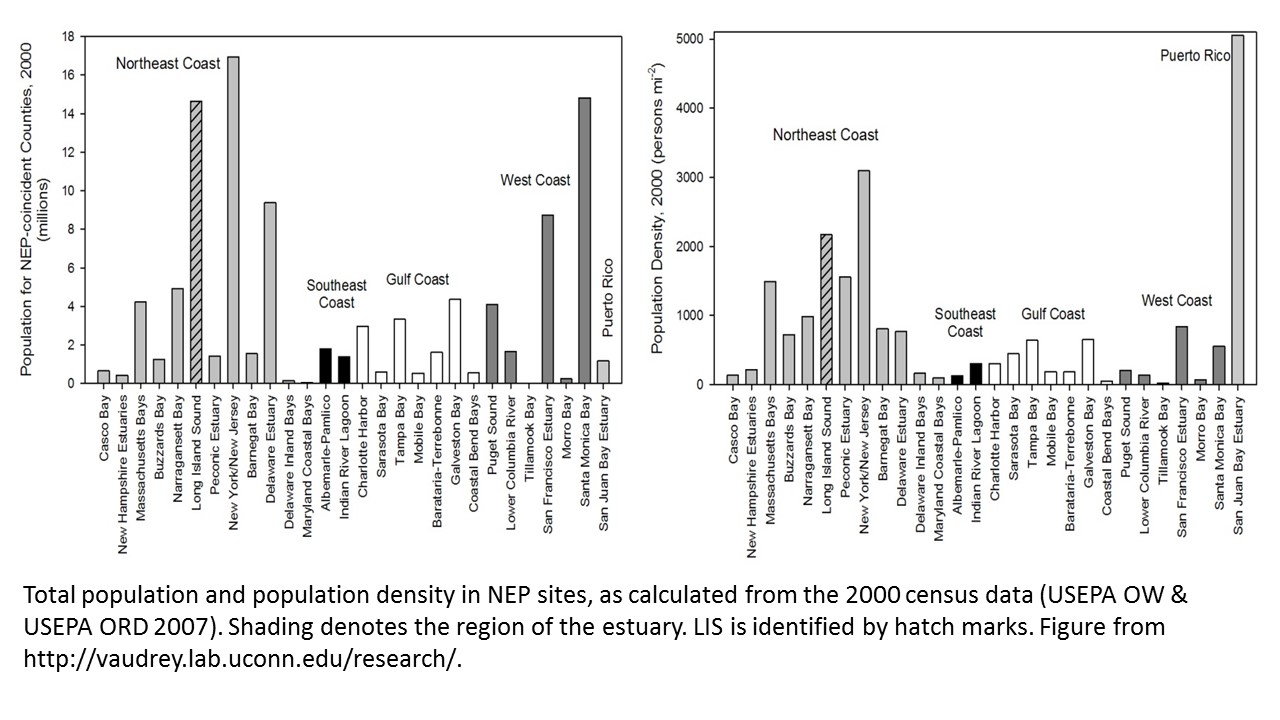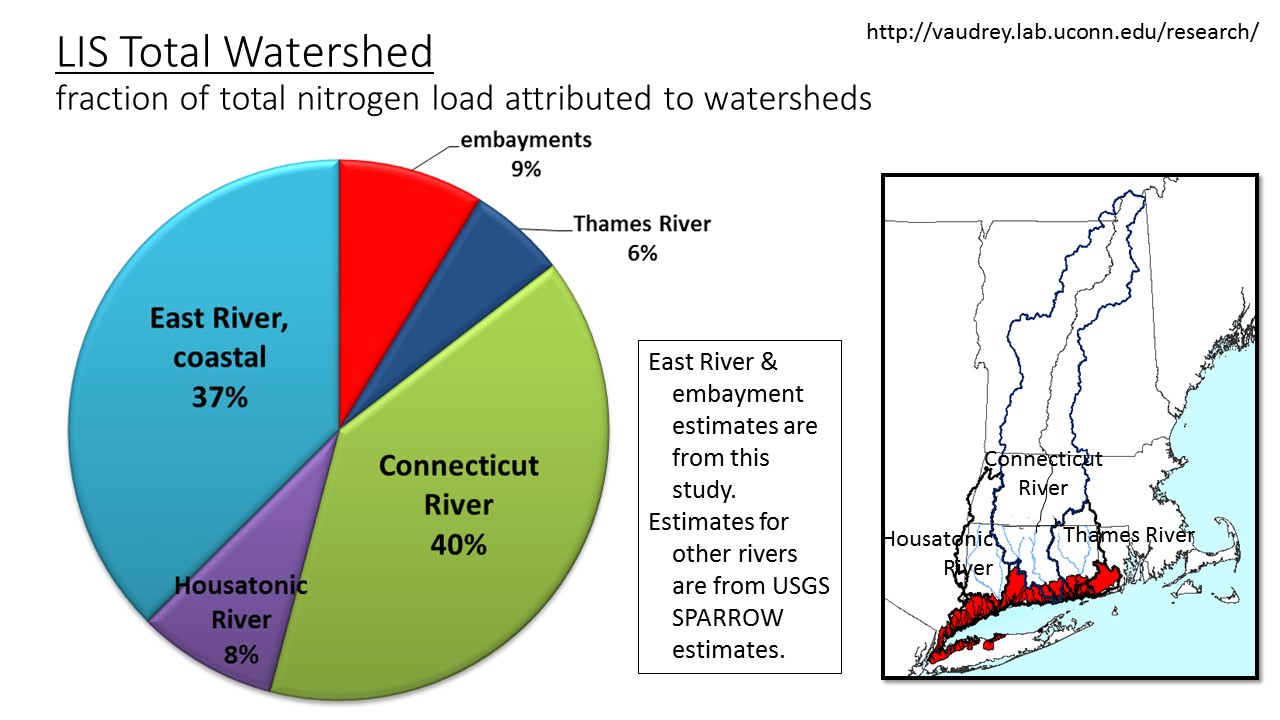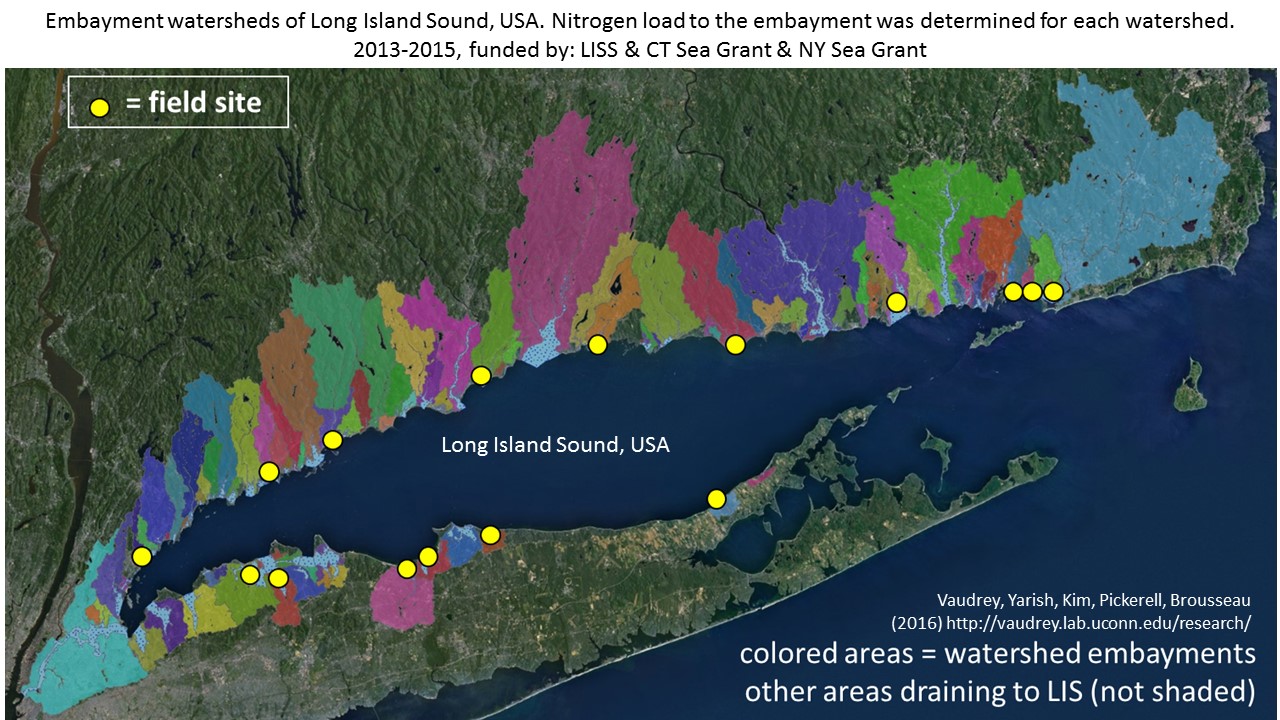Comparative analysis and model development for determining the susceptibility to eutrophication of Long Island Sound embayments.
Jamie Vaudrey, Charlie Yarish, Jang Kyun Kim, Chris Pickerell, Lorne Brousseau
with Justin Eddings, Veronica Ortiz Tanguay, Claudia Koerting, Michael Sautkulis
2013-2015, funded by: LISS & CT Sea Grant & NY Sea Grant
An embayment is defined as a recess in a coastline or an indentation off a shoreline which forms a bay. In Long Island Sound, the names of embayments often include the words Harbor (27%), River (23%), Cove (19%), Bay (10%), Creek (10%), and Pond (7%); with a few including the names Brook, Gut, Inlet, or Lake. These embayments are where people interact with Long Island Sound. They are the sites of our marinas and host our beaches and parks. People use embayments for kayaking, swimming, fishing, crabbing, and other recreational activities. These areas serve as nurseries and foraging ground for many commercially and recreationally important species of animals.
Figure 1 – Long Island Sound, sometimes called the “Urban Sea,” is a body of water heavily impacted by the dense populations along it’s coastline. A comparison of the population among the 28 National Estuary Programs across the country places Long Island Sound as the third densest population; only the New York / New Jersey Harbor and San Juan Bay Estuary in Puerto Rico have a greater population density than Long Island Sound. A fact not captured by these data are the impact the New York / New Jersey Harbor has on Long Island Sound via the East River.
Figure 2 – A comparison of the total nitrogen load contributed to Long Island Sound from the embayments and the coastal portions of the four largest rivers indicates the East River accounts for 78% of the nitrogen load from the coastal regions (area shaded red in the figure). Including the load from the whole watershed of each of these four major rivers further increases their impact on the total load, with the Connecticut River and the East River contributing ~80% of the nitrogen load to Long Island Sound. Long Island Sound’s local load coupled with the influence of the East River arguably makes Long Island Sound the most urbanized of estuaries in the United States.
Figure 3 – The embayments of Long Island Sound contribute roughly a fifth of the total load of nitrogen to the Sound from the coastal watersheds (red areas in Figure 1) when compared to the coastal portions of the four major rivers. The fraction of nitrogen loading due to embayment watersheds drops to ~10% when considering the area outside of the coastal zone. Reducing nitrogen from these embayments is critical to efforts to reduce nutrient loads overall. Embayments are vital to an effective campaign for nutrient reduction to Long Island Sound because they are areas that incite people’s passion and interest. While the embayment contribution to Long Island Sound’s nitrogen load is relatively small (<20%), people are interested in the local effects of nitrogen on “their” embayment; and these effects can have a substantial impact on local embayment water quality. This local concern can be leveraged to generate actions to reduce loads to the embayments, and perhaps more importantly, to educate people on how and why nitrogen loading is impacting Long Island Sound overall. The environmental movement uses the phrase “Think Global, Act Local” to get people motivated to enact reform. But flipping this phrase to “Think Local, Act Global” is pertinent to the nitrogen load issues for Long Island Sound. By increasing awareness at a local level and encouraging local actions, we will develop a populace with a better understating of why reductions of nitrogen load are critical to creating the Long Island Sound we want in our backyard.
Results from this study have identified the trophic status in 2011-2014 of fifteen embayments of Long Island Sound, estimated the nitrogen load and sources of nitrogen to all embayments of Long Island Sound, and established a list of embayments most likely to be experiencing the impacts of eutrophication. Interested in learning more? Please check out the links below…
EPA Quality Assurance Project Plan
Embayment Nitrogen Loads for Long Island Sound, presentation of completed project
Long Island Sound Nitrogen Loading Model, 2016 version – Excel file, Interactive Map
Long Island Sound Nitrogen Loading Model – ArcGIS files – LIS-NLM-2016_v20200205.zip
Recorded Webinar on the Project, courtesy of UConn CLEAR
Works Cited
USEPA OW, USEPA ORD. (2007) Chapter 2: Condition of National Estuary Program Sites — A National Snapshot. In National Estuary Program Coastal Condition Report. U.S. Environmental Protection Agency, Office of Water and U.S. Environmental Protection Agency, Office of Research and Development, Washington, DC.


